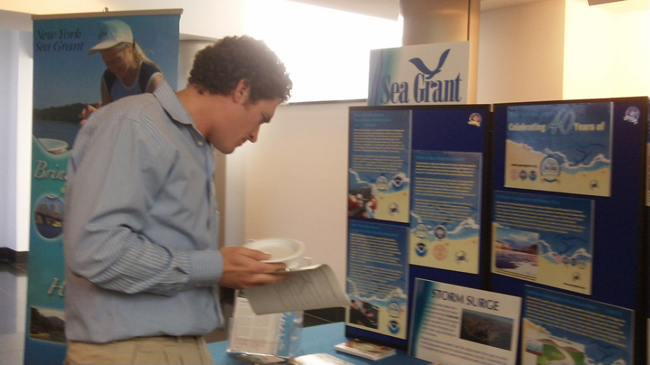The swatch of ocean stretching from the eastern tip of Long Island to New Jersey’s Cape May, known as the New York Bight, was the subject of a brisk-paced conference that convened in September at Stony Brook University’s Wang Center. The New York Marine Sciences Consortium (NYMSC) met for its Annual Conference in order to review the research priorities for implementing ecosystembased management (EBM) in the New York Bight.
Matt Gove, of the Bureau of Marine Resources at the New York State Department of Environmental Conservation (NYSDEC), led the conference proceedings, which began with a morning of short presentations from New York and New Jersey scientists on various environmental topics on the history, current status, and future conservation concerns for the New York Bight. After a short lunch break, the Consortium split into discussion groups, and spent the afternoon discussing and refining the research needs for EBM. The release of that final list of research needs will somewhat be delayed due to the aftermath of Hurricane Sandy.
A highlight of the morning presentations was that of
Larry Swanson from Stony Brook University’s School of Marine and Atmospheric Sciences (SoMAS) who discussed a lot of the history of environmental activity in NY Bight. He showed photos of dumping refuse and sludge in the NY Bight until bad publicity and public outrage lead to the Ocean Dumping Ban Act of 1988 and other environmental legislation.
John Marra of Brooklyn College discussed the physical oceanography of the Bight, and its effects on nutrient cycles from the mouth of the Hudson River out to the continental shelf. From Hunter College,
Karl Szekielda explained how remote sensing is used to recognize algal blooms and other ocean phenomena, depending on the resolution and time scale of the image set.
SoMAS scientist,
Charlie Flagg (see links to his photos of Fire Island damage caused by Sandy), described the Oleander Project, the result of a partnership that takes advantage of the weekly round-trip trek from New York to Bermuda for valuable data collection. The M.V. Oleander has collected temperature and salinity measurements weekly since 1978, and has provided an invaluable historic dataset which details the movement of the Gulf Stream through the year.
Another SoMAS scientist,
Mike Frisk, reported on the recent telemetry research illuminating previously unknown facets of the Atlantic Sturgeon’s life history. Using an array of acoustic telemetry receivers along the Long Island coast, Frisk’s lab has gained new insight into the location and timing of spawning aggregations in this threatened species.
From Rutgers University,
Doug Ofiara examined the effect of floatable waste on public use of New York and New Jersey’s beach and coastal areas, and the subsequent economic losses in those areas. This research provides key calculations of the social value of damage due to pollution.
Christa Farmer, an expert from Hofstra University of the New York Bight’s paleotempestology – the study of ancient storms - described her research of how storm tracks have changed over millennia. Understanding patterns and how they are shifting with climate change is vital for developing long-term coastal management plans.
– Sharon Benjamin and Barbara A. Branca

New York Sea Grant was at the table at the 5th Annual New York Marine Sciences Consortium Research Symposium, held Sept 22, 2012 at Stony Brook University's Wang
Center. Photo courtesy of Barbara A. Branca. More photos from the event via
NYSG's Flickr site.